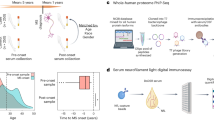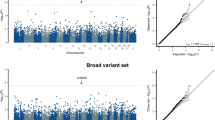Abstract
Variation within intron 19 of the CLEC16A (KIAA0350) gene region was recently found to be unequivocally associated with type 1 diabetes (T1D) in genome-wide association (GWA) studies in Northern European populations. A variant in intron 22 that is nearly independent of the intron 19 variant showed suggestive evidence of association with multiple sclerosis (MS). Here, we genotyped the rs725613 polymorphism, representative of the earlier reported associations with T1D within CLEC16A, in 1037 T1D cases, 1498 MS cases and 1706 matched controls, all from the founder, autoimmunity-prone Sardinian population. In these Sardinian samples, allele A of rs725613 is positively associated not only with T1D (odds ratio=1.15, P one-tail=5.1 × 10−3) but also, and with a comparable effect size, with MS (odds ratio=1.21, P one-tail 6.7 × 10−5). Taken together these data provide evidence of joint disease association in T1D and MS within CLEC16A and underline a shared disease pathway.
This is a preview of subscription content, access via your institution
Access options
Subscribe to this journal
Receive 6 digital issues and online access to articles
$119.00 per year
only $19.83 per issue
Buy this article
- Purchase on Springer Link
- Instant access to full article PDF
Prices may be subject to local taxes which are calculated during checkout
Similar content being viewed by others
References
Marrosu MG, Cocco E, Lai M, Spinicci G, Pischedda MP, Contu P . Patients with multiple sclerosis and risk of type 1 diabetes mellitus in Sardinia, Italy: a cohort study. The Lancet 2002; 359: 1461–1465.
Nielsen NM, Westergaard T, Frisch M, Rostgaard K, Wohlfahrt J, Koch-Henriksen N et al. Type 1 diabetes and multiple sclerosis: A Danish population-based cohort study. Arch Neurol 2006; 63: 1001–1004.
Marrosu MG, Motzo C, Murru R, Lampis R, Costa G, Zavattari P et al. The co-inheritance of type 1 diabetes and multiple sclerosis in Sardinia cannot be explained by genotype variation in the HLA region alone. Hum Mol Genet 2004; 13: 2919–2924.
Hakonarson H, Grant SF, Bradfield JP, Marchand L, Kim CE, Glessner JT et al. A genome-wide association study identifies KIAA0350 as a type 1 diabetes gene. Nature 2007; 448: 591–594.
Todd JA, Walker NM, Cooper JD, Smyth DJ, Downes K, Plagnol V et al. Robust associations of four new chromosome regions from genome-wide analyses of type 1 diabetes. Nat Genet 2007; 39: 857–864.
Hafler DA, Compston A, Sawcer S, Lander ES, Daly MJ, De Jager PL et al. Risk alleles for multiple sclerosis identified by a genomewide study. N Engl J Med 2007; 357: 851–862.
Thomson G . Mapping disease genes: family-based association studies. Am J Hum Genet 1995; 57: 487–498.
Lampis R, Morelli L, Congia M, Macis MD, Mulargia A, Loddo M et al. The inter-regional distribution of HLA class II haplotypes indicates the suitability of the Sardinian population for case-control association studies in complex diseases. Hum Mol Genet 2000; 12: 2959–2965.
McDonald WI, Compston A, Edan G, Goodkin D, Hartung HP, Lublin FD et al. Recommended diagnostic criteria for multiple sclerosis: guidelines from the international panel on the diagnosis of multiple sclerosis. Ann. Neurol 2001; 50: 121–127.
Dudbridge F . Pedigree disequilibrium tests for multilocus haplotypes. Genet Epidemiol 2003; 25: 115–121.
Spielman RS, McGinnis RE, Ewens WJ . Transmission test for linkage disequilibrium: the insulin gene region and insulin-dependent diabetes mellitus (IDDM). Am J Hum Genet 1993; 52: 506–516.
Zoledziewska M, Perra C, Orru V, Moi L, Frongia P, Congia M et al. Further evidence of a primary, causal association of the PTPN22 620W variant with type 1 diabetes. Diabetes 2008; 57: 229–234.
Bottini N, Vang T, Cucca F, Mustelin T . Role of PTPN22 in type 1 diabetes and other autoimmune diseases. Semin Immunol 2006; 18: 207–213.
Vang T, Congia M, Macis MD, Musumeci L, Orru V, Zavattari P et al. Autoimmune-associated lymphoid tyrosine phosphatase is a gain-of-function variant. Nat Genet 2005; 37: 1317–1319.
Acknowledgements
We thank Mario Maioli, Daniela Contu, Costantino Motzo, Franca Zurrida, Francesca Deidda, Gabriele Farina, Paola Cossu and Wanda Garau for help and support. This work was supported by funds from FISM-Fondazione Italiana Sclerosi Multipla—Cod. 2004/R/5to FC and from Regione Autonoma Sardegna (Progetto Educazione Sanitaria) to FC.
Author information
Authors and Affiliations
Corresponding author
Rights and permissions
About this article
Cite this article
Zoledziewska, M., Costa, G., Pitzalis, M. et al. Variation within the CLEC16A gene shows consistent disease association with both multiple sclerosis and type 1 diabetes in Sardinia. Genes Immun 10, 15–17 (2009). https://doi.org/10.1038/gene.2008.84
Received:
Revised:
Accepted:
Published:
Issue Date:
DOI: https://doi.org/10.1038/gene.2008.84
Keywords
This article is cited by
-
Multiple sclerosis epidemiological trends in Italy highlight the environmental risk factors
Journal of Neurology (2022)
-
Autoimmunity in Primary Immunodeficiencies (PID)
Clinical Reviews in Allergy & Immunology (2022)
-
The Genetic Contribution to Type 1 Diabetes
Current Diabetes Reports (2019)
-
Genomic history of the Sardinian population
Nature Genetics (2018)
-
Genome sequencing elucidates Sardinian genetic architecture and augments association analyses for lipid and blood inflammatory markers
Nature Genetics (2015)



